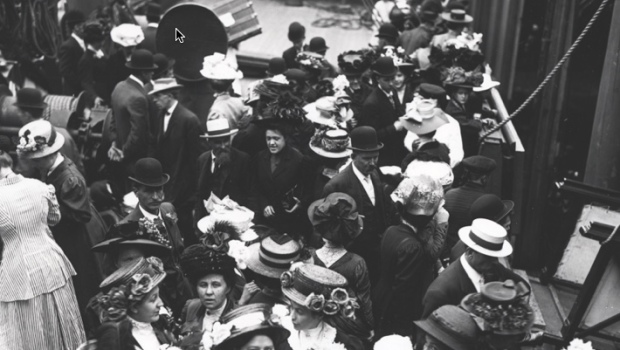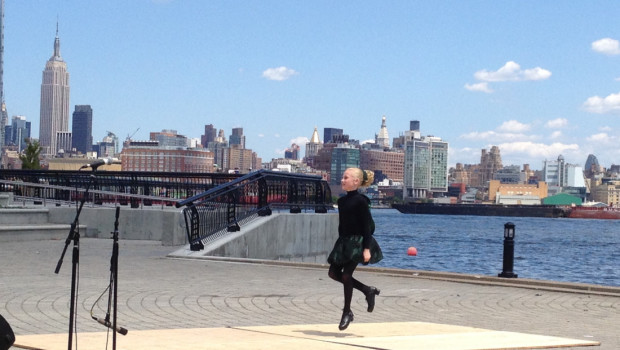
Port of Entry to a Continent
Story by: Melissa Abernathy
Photos Courtesy of Hoboken Historical Museum Collections,
Collection of the Library of Congress & Harvard University Library
Today, Hoboken’s piers host concerts, Movies under the Stars, soccer games and sightseers. A century ago, hordes of people also crowded Hoboken’s piers, but for a different reason: these piers were the “port of entry to a continent.”
That phrase, taken from a History of Hudson County published in 1924 by Daniel Van Winkle, describes Hoboken’s role in the Port of New York-New Jersey during the peak period of U.S. immigration, 1892 – 1924, when some 20 million people immigrated to the United States. More than half, 12 million, passed through the Port of New York and Ellis Island, and a good many came through Hoboken, with some settling here and putting down roots.
Hoboken was a predominantly German and Irish community in the 1890 census. The immigrants that passed through Ellis Island between 1892-1924 reshaped Hoboken’s demographics, and fueled the city’s economy as well. In 1890, 40 percent of Hoboken’s 43,648 residents were foreign-born and the majority of the city’s native-born residents had parents born in Germany or Ireland. Only 790 Italian immigrants lived in Hoboken in 1890.
Just two decades later, in 1910, Germans and German- Americans continued to dominate Hoboken, but for the first time, the city had more Italian and Italian- American residents than Irish and Irish-Americans. Hoboken also had a growing number of residents born in Russia, Austria, and Norway.
The role that Hoboken’s piers played in U.S. immigration history is detailed in the new exhibit, “Hoboken, Ellis Island, and the Immigrant Experience, 1892-1924,” on view August 3 – December 23 at the Hoboken Historical Museum, 1301 Hudson Street. Guest curator Dr. Christina Ziegler-McPherson, an immigration historian who lives in Hoboken, collaborated with museum director Bob Foster and their collections manager to bring to life the experiences of immigrants who passed through Ellis Island and Hoboken. They used images, artifacts, and oral histories from the peak years of U.S. immigration.
Why Hoboken? Location, location, location. Hoboken’s piers were the U.S. port for four of Europe’s major passenger shipping lines: Hamburg- America Packet Company, North German Lloyd Steamship Company, Scandinavian-American Line, and Holland America Line, while others, Cunard, White Star, and more, docked on the Manhattan side of the Hudson River.
The Immigration Act of 1891 established federal control over immigration for the first time. Immigrants were to be screened for physical and mental disabilities, criminal and immoral backgrounds, and extreme poverty at 24 points of entry. Even though ‘unacceptable’ individuals were sent back to their port of origin at the shipping companies’ expense, the transatlantic passenger ship lines eagerly responded to a surge in demand with larger, faster ships.
Suddenly, Ellis Island, a former munitions depot, became the country’s most heavily used immigration station. Immigration to the U.S. spiked, and shifted from Northern and Western Europe to Eastern and Southern Europe. For the first time, the primary countries of origin were Austria-Hungary (including southern Poland, the Czech Republic, Slovakia, Slovenia, Croatia, Bosnia-Herzegovina, and northern Romania), Italy, and Russia (including eastern Poland, Finland, Estonia, Latvia, Lithuania, the Ukraine, Belarus, Moldova, and Georgia), supplanting Germany, Ireland, and Great Britain.
The Immigrant Experience
Immigrants’ experiences’ varied greatly by their port of origin. Germany passed laws requiring the passenger shipping lines to manage control stations at its borders with Russia and Austria, where would-be immigrants were screened for disease, disability, and poverty, and disinfected of lice before entering. Soon, Germany also required steamship companies to house immigrants at their ports of embarkation, to keep travelers quarantined from the general population. These facilities could house 4,000 people at one time, and had dormitories, kosher kitchens, hospitals, bathhouses, and churches and synagogues.
In Genoa and Naples, however, conditions were rougher. In Genoa, immigrants would camp out by the docks or sleep on the street, while in Naples, immigrants crowded into overpriced boarding houses. In Naples, immigrants were examined by U.S. Marine-Hospital Service doctors and then again by the ship’s doctor at the gangway to prevent substitutions for healthy persons by diseased ones.
Other European shipping companies also built screening facilities at their main por ts to prevent having to transport rejected immigrants back from America. This corporate medical inspection was effective: for every one person denied entry at Ellis Island, the steamship companies themselves denied passage to five would-be immigrants.
Class Divides on Board
Once on board, each passenger class had its own deck and separate eating and sleeping facilities. First-class cabin passengers had sumptuously appointed cabins with private bathrooms, and they dined in elegant dining rooms set with the finest china and silver, waited on by staff and fed by gourmet chefs. Second-class passengers enjoyed private cabins, but shared toilets with other passengers on their deck.
For cabin passengers, transatlantic travel was like staying in a luxury hotel. For steerage passengers, the only benefits of the boom in ocean travel were that it was fast and relatively cheap. They shared large rooms that could hold up to 300 people, sleeping in bunk beds 6 feet long by 2 feet wide, stacked two or three levels high with 2 ½ feet between them. They were often segregated by sex and marital status. Toilet and bathing facilities were also communal in steerage. Steerage passengers were fed cafeteria-style in large dining halls, and were often expected to wash and reuse their utensils and dishes for each meal.
On arrival in New York Harbor, the class system continued. Every morning at 5:30 a.m., doctors from the U.S. Marine-Hospital Service would sail out to boats that arrived the night before in the harbor to interview first and second-class cabin passengers in their cabins.
After being cleared by federal customs and state and federal health officials to dock, the ship would sail into its berth at the piers in either Manhattan or Hoboken. Cabin passengers would disembark and were free to catch trains to the interior or ferries to Manhattan.
Steerage passengers remained on board until they were ferried to Ellis Island, where they again underwent another health examination. Then, Bureau of Immigration officials interviewed each individual, asking twenty-nine questions and comparing the answers to the ones recorded on the ship’s manifest at boarding. The goal was to prevent the entry of “undesirables”, including polygamists, anarchists, the physically and mentally disabled, pauper, those liable to be a public charge, prostitutes and others convicted of “crimes of moral turpitude,” and persons with a “loathsome or contagious disease.”
If there were no health or other problems, the immigrant was formally admitted to the U.S. and allowed to collect his or her luggage and take the ferry either back to Hoboken or to New York City. Immigrants who were flagged for health or other reasons were detained on site to be interviewed more extensively. About 2 percent of immigrants were excluded, mostly for health reasons.
Immigration Equals Jobs
The surge in immigration created a huge regional economic boom. About 4,600 Hoboken residents, or 15 percent of the city’s working population, held jobs directly and indirectly tied to immigration and shipping: merchant seamen, longshoremen, luggage porter, teamsters, cab drivers, hotel guides or “runners”, hotel owner, saloon keepers, steamship ticket agents, and more.
In 2006, the Museum interviewed Paul Samperi, whose father Joseph was a one-time “hotel runner,” for the oral history chapbook series, “Vanishing Hoboken.” Samperi explained:
“Now what does a runner do? He goes down to the steamship lines, and he mentions to the people coming in who he is and what hotel he represents, and ‘Would they like to stay at the hotel?’ Most of them would stay a day or two at the hotel, then they would get tickets on railroads going out west. … So he would go to the German lines, the Holland line, and he would tell them, ‘I’m from so-and-so hotel…We’d like to have you. We’ll take care of all your needs. If you’d like us to get you tickets, to anywhere in the United States, we’ll be glad to take care of you.” (excerpt from A Nice Tavern, Remembering the Continental Hotel and the Union Club, Recollections of Paul Samperi, Hoboken Historical Museum, 2008.)
The entire oral history series, over 25 separate chapbooks, is archived in downloadable PDF form on the website, www.hobokenmuseum.org, and many are available for $3 in the Museum gift shop.
War and Immigration Backlash Doom Ellis Island
Immigration plummeted after World War I began in late July 1914. That year, more than 1.2 million immigrants entered the U.S.; in 1916 only 298,826 people immigrated, the lowest number since the 1898 recession.
After the war, the U.S. passed the 1921 Quota Act, limiting the number of entries to 350,000 per year, with quotas of 3 percent of each nationality living in the U.S. in 1910. Canada and Mexico were exempt from the quotas. In 1921, the U.S. admitted 805,228 people; in 1922, only 309,556 people were admitted.
In 1924, an even further restrictive Immigration Act was passed, lowering the quota levels to 150,000 entries per year, based on groups that had been living in the U.S. in 1890. Germans, Irish, English, and other Northern Europeans received the vast majority of quota allotments, while Italians and people from the former Russian, Austro-Hungarian, and Ottoman empires, were greatly restricted.
The 1924 law also initiated the entry-visa system by State Department consulates in immigrants’ home countries, eliminating the need for screening at Ellis Island. After 1924, the only people detained at Ellis Island were those who had problems with their paperwork, and war refugees.
Learn more about U.S. immigration and Hoboken’s vital role during its peak period by visiting the Hoboken Historical Museum, open 6 days a week in one of the oldest buildings on the waterfront, 1301 Hudson Street. Admission is just $2. ••

 Previous Article
Previous Article Next Article
Next Article FRIDAYS ARE FOR FRANK: “Have You Met Miss Jones?”
FRIDAYS ARE FOR FRANK: “Have You Met Miss Jones?”  FRIDAYS ARE FOR FRANK: “Nice ‘n’ Easy” (Sinatra Social Distancing)
FRIDAYS ARE FOR FRANK: “Nice ‘n’ Easy” (Sinatra Social Distancing)  Hoboken Irish: the True Nature of Our City’s Irish-American Community
Hoboken Irish: the True Nature of Our City’s Irish-American Community  RING-A-DING-DING: It’s Frank Sinatra’s Birthday, Baby!!!
RING-A-DING-DING: It’s Frank Sinatra’s Birthday, Baby!!!  OH, THE HUMANITY: Blimpie Crashes Out of Hoboken
OH, THE HUMANITY: Blimpie Crashes Out of Hoboken  FRIDAYS ARE FOR FRANK: “A Day In The Life Of A Fool”
FRIDAYS ARE FOR FRANK: “A Day In The Life Of A Fool”  FRIDAYS ARE FOR FRANK: “Half As Lovely (Twice As True)”
FRIDAYS ARE FOR FRANK: “Half As Lovely (Twice As True)”  John Stevens, Avid Gardener | Hoboken’s Horticultural History
John Stevens, Avid Gardener | Hoboken’s Horticultural History